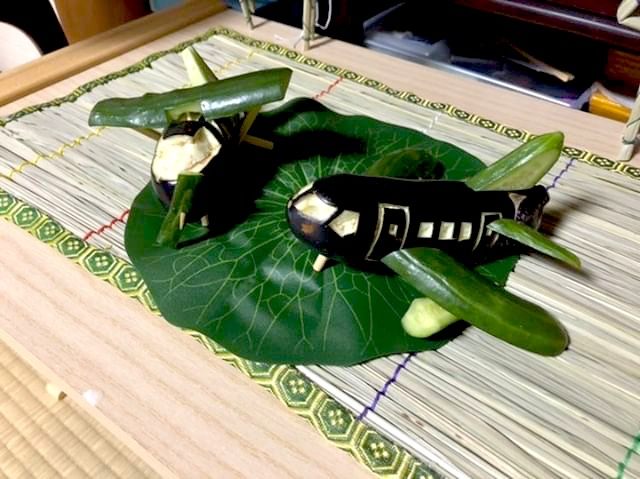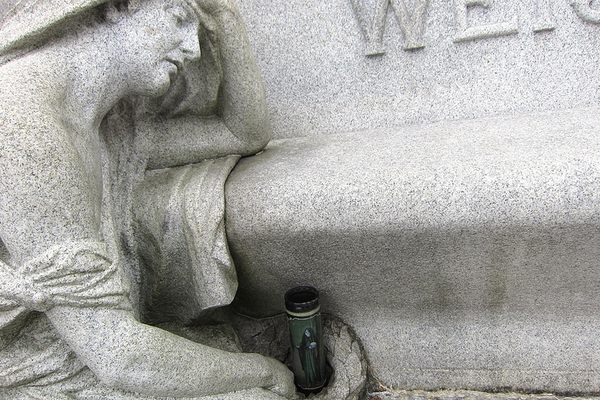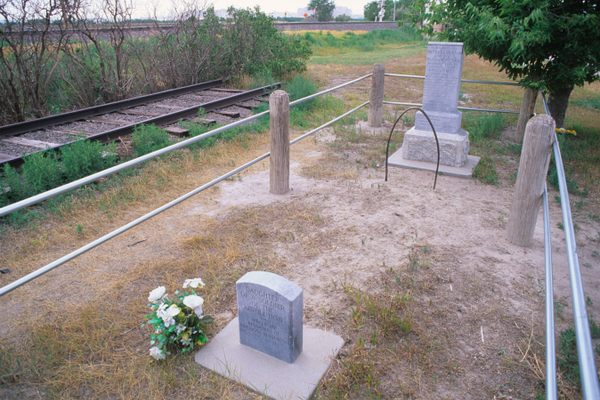The Cucumber Horses and Eggplant Cows That Welcome Back the Dead
During the Japanese summer festival Obon, ancestral spirits come home.

On a sweltering morning in August, three generations of the Tasaki family walk up the hill to the family grave. There, five generations of Tasakis have been laid to rest; they look out over the rice terraces in Takachiho, a rural mountain town in southern Japan. Toshiko, wearing a bonnet that shades her face from the relentless sun, sweeps around the grave with a twig broom while her son, Tomonori, refills white porcelain cups with offerings of water and sake. His wife, Tomoko, lifts three-year-old Hibito up to arrange fresh flowers in bamboo-shaped plastic vases. A curl of incense smoke rises as Toshiko brings her hands together in prayer. It’s silent except for the drone of cicadas.
Cleaning the grave is the first ritual of Obon, a Japanese summer festival when ancestral spirits are welcomed back home for a three-day family reunion in the world of the living. During Obon, they’re honored with offerings of favorite foods, bonfires, and lively dances, before being led back to the land of the dead on a river of floating lanterns.
Like any family reunion, there’s cooking to be done after the cleaning. “A lot of Obon foods are for display rather than consumption,” says Elizabeth Andoh, author of the cookbooks Kansha and Washoku, who was born and raised in New York but has made her home in Japan since the 1960s. One of those food offerings is mizunoko. Toshiko helps Hibito scoop the mixture of diced eggplant and uncooked white rice onto a persimmon leaf, which they lay on the family tomb and in front of the mossy Buddhist statues, called ojizousama, that dot the family farmland. “It’s like a bento for when our ancestors go back to heaven, to ensure that they get there,” explains Tomoko. In other parts of Japan, mizunoko might be served on a lotus or taro leaf, with chopped cucumbers mixed in.

While Obon is celebrated all over Japan, the flavors therein vary from family to family and region to region. In Shikoku, people press stripes of sushi ingredients into a box, not unlike a layer cake. Called hakozushi, it’s commonly served at summer family gatherings. Bondara, stewed and dried codfish, is a go-to in Kyushu since dried foods keep better in the heat. Buddhist supply shops offer customized sets of Obon altar decorations, such as bamboo fronds or dried Chinese lantern plants, depending on local traditions.
In nearby Saga prefecture, where Tomoko grew up, the cucumbers and eggplants take on another form. Skewer each of them with four bamboo legs, and add tails made out of cornsilk, and these typical summer vegetables become shouryouma, or “spirit horses.” The cucumber horse is long and sleek, symbolizing ancestors’ swift journeys home to their families. The eggplant cow, plump and sturdy, embodies ancestors’ leisurely return trip, a load of souvenirs with them in tow.
While this long-standing tradition is practiced in many parts of Japan, younger generations have been riffing on it in new ways, carving their summer vegetables into elaborate creations and posting them online. For some people, shouryouma represents a special way to pay tribute to their loved ones.

Tatsuya Ezura, who is studying to be a pilot, made an eggplant Cessna—complete with cucumber wings—for his late grandmother. “I wanted to be a pilot for a long time, but I gave up for a while. Now I’m working hard but I can’t show that to my grandmother,” he explains. “I made this cucumber airplane so that my thoughts might reach her.”

Masashi Isamu carved his shouryouma into the shape of a dog. “My grandmother passed away last February, so this is her arabon, the first Obon following one’s death,” he says. “She was very close to our golden retriever, Coron. I think she would be very pleased.”
After Obon, Coron ate the eggplant, though Shouryouma aren’t usually consumed. Japanese etiquette blogs note that the traditional method of disposal for Obon offerings is returning them to the earth or releasing them into a river. A more modern option calls for sprinkling the offerings with purifying salt, wrapping them in white paper, and throwing them out with the trash. Victoria Yoshimura, a Buddhist priest at Shonenji Temple in Takachiho, says that it’s a misconception that Obon food offerings shouldn’t be eaten by the living, though: “It’s rude to waste food in Buddhism, and this is blessed food as it has been offered to the hotokesama [deceased ancestors, who themselves have become buddhas].” Keeping up with the steamy Japanese summer weather, however, when food spoils quickly, is a challenge.

In the valley downriver from Takachiho, Tomomi Kinoshita chats with her ancestors about family updates—a successful tennis match, a daughter’s date—as she serves them a meal. “Hai, douzo,” she says, setting red and gold lacquer dishes on the butsudan, the Buddhist family altar. There, she offers incense daily to photos of deceased family members. Her husband is the eldest son of his family, so their household maintains the Kinoshita family butsudan—and though more and more Japanese are taking advantage of rare time off at Obon to travel, siblings who move away are traditionally expected to come back this time of year and pay their respects.
During the three days of Obon, the population rural towns such as this one—many have since left for larger cities—will swell. Tomomi will be feeding both living and dead houseguests. But rather than cooking special offerings for the departed, she says, “our ancestors want to eat the foods they usually ate in life.” As Toshiko puts it, “We’re all one family. So if we’re eating jelly, we’ll serve them jelly, too.” With one caveat—the ancestors are vegetarian. “Both Shinto and Buddhism occur simultaneously in Japan,” explains Andoh. “Most rituals associated with end-of-life ceremonies, like Obon, are Buddhist, and any ritual food related to a Buddhist ceremony is going to be shoujin-ryouri, without flesh.”
Rakugan, neon-hued sweets made from sugar and rice starch pressed into the shape of peaches, bunches of grapes, bananas, and lotus flowers, are the icing on the Obon altar. Another must for sweet-toothed spirits is dango, chewy balls of mochi. The Kinoshitas love them topped with a dusting of nutty, roasted soybean powder. But for the ancestors, they leave them plain. “I don’t know why, but spirits like white dango,” laughs Tomomi.

On the last night of Obon, the Kinoshitas gather with their neighbors at the river that cuts through the center of town. With them is a small wooden boat that Tomomi’s father-in-law makes every year. It’s always stuffed by her mother-in-law with gifts for the ancestors: flowers, fruit, a bottle of saké, and more dango.
“We say goodbye in our hearts,” says Tomomi, as the neighbors lower their boats and glowing paper lanterns into the water and watch them bob downstream. Then, a riot of fireworks explodes overhead and everyone heads back to the town’s summer festival for beer and an Obon folk dance called bon-odori.
Tomomi says that Japanese people feel happy during Obon because they get to meet their loved ones again. Even Andoh’s parents, the children of Jewish immigrants, were so moved by the tradition that their last wishes were to be cremated and taken with her to Japan. “They had seen Obon several times in the course of my being in Japan, and they loved the way the departed were treated, rather than being thrown into some cemetery where people never go,” she says. “The fact that ancestors are acknowledged, revisited, that things are shared with them, it’s rather nice and it helps bring a sense of closure to the living. I think a lot of the rituals in Japan surrounding death are actually to benefit survivors.”
For Tomoko, Obon is about gratitude for those who came before. “Thanks to them, I can say I’m alive,” she says. “Without them, I don’t exist.”
Gastro Obscura covers the world’s most wondrous food and drink.
Sign up for our regular newsletter.




































Follow us on Twitter to get the latest on the world's hidden wonders.
Like us on Facebook to get the latest on the world's hidden wonders.
Follow us on Twitter Like us on Facebook